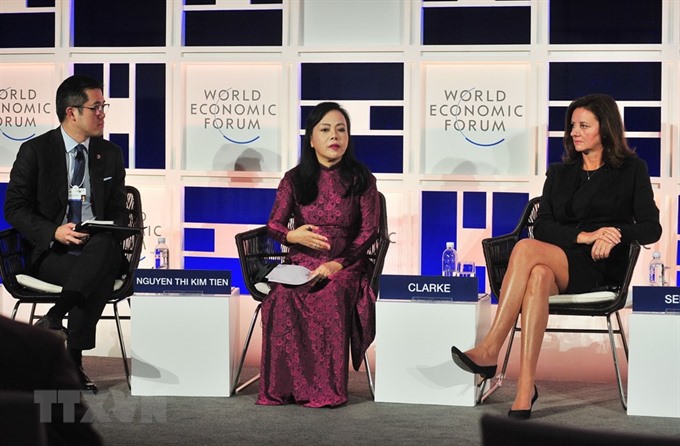 Society
Society

A rapidly aging population and increasing rate of modern diseases are considered the biggest challenges to the healthcare sector of Southeast Asian nations, but technological innovations might offer a solution.
 |
| Vietnamese Minister of Health Nguyễn Thị Kim Tiến (c).— VNA/VNS Photo Nguyễn Khang |
HÀ NỘI — A rapidly aging population and increasing rate of modern diseases are considered the biggest challenges to the healthcare sector of Southeast Asian nations, but technological innovations might offer a solution.
The idea was agreed upon by health officials, experts and international pharmaceutical groups at a forum on the healthcare systems in members of the Association of Southeast Asian Nations (ASEAN) that opened on Thursday in Hà Nội as part of the World Economic Forum on ASEAN.
David Sin, Co-founder and President of the Fullerton Health Group in Singapore, said that the population in the Asia-Pacific region, including Southeast Asia, are aging much faster than in other parts of the world.
Asia is also forecast to have about 460 million people over 65 in the next decade, 65 million are forecast to suffer from diabetes, while 275 million people over 18 years old will be obese.
Sin added that the total spending on healthcare in the region will soon account for 45 per cent of the global amount due to rapidly rising demand.
Việt Nam, like other ASEAN countries, faces the constant threat of infectious tropical diseases exacerbated by new strains and new diseases like drug-resistant tuberculosis, MERS or Zika, said Vietnamese Minister of Health Nguyễn Thị Kim Tiến.
“A rising number of non-infectious diseases with very high rates of fatality, like high blood pressure, diabetes and cancer are also burdening the country,” she said.
“Another problem is the aging population which is pushing the need for healthcare services. However, resources are very limited.”
Tiến said that Việt Nam wanted to apply smart technologies in the health sector to solve the current patient overload at hospitals and catch up with the increasing demand for healthcare services.
The minister said that the country was working to set up three smart healthcare systems, including smart hospitals, smart approach to patients and smart health administration.
The Government has invested heavily in smart technology but it was yet to meet expectations, Tiến added.
Head of Novertis Asia Pacific Pharmaceuticals, Alexis Serlin, said that innovation and cutting edge technologies in treatment would create new opportunities for the healthcare system to tackle such issues.
Rapid development in pharmaceutical science or stem cell technology, for example, would fundamentally cut medicine costs for patients, he said.
He also said that a digital health database would help doctors and hospitals better track and follow up treatments for patients and evaluate results.
Royal Philips’ Asia Pacific chief executive officer Caroline Clarke mentioned a new trend emerging, including in ASEAN countries – healthcare services at home.
According to Clarke, the hospital and clinic system could no longer meet the healthcare demand of the aging population and an ever-growing number of patients in the region.
As home healthcare was gaining steam, Clarke suggested the use of artificial intelligence (AI) to support doctors. They could monitor treatment for patients from a far with the help of AI, she said, and hence improve and guarantee the quality of services. — VNS




